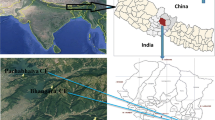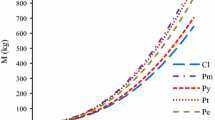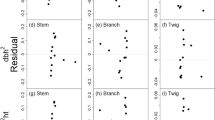Abstract
Key message
The density-integral approach worked well for estimating whole-tree and dominant stem vertical biomass profiles, and performed better than the constant-density approach for biomass prediction.
Abstract
Integrated whole-tree biomass equations are in great demand due to the simultaneous need to improve estimation of forest carbon stocks and to quantify the distribution of wood biomass within trees for estimating whole-tree utilization potential. Two approaches were used for modeling the vertical cumulative biomass profile of a whole tree from the ground to the top of the tree, including the dominant stem and branches: (1) a density-integral approach and (2) a constant-density approach. The models were developed from destructive sampling of 27 trees from a temperate hardwood forest in Michigan, USA. The species sampled were American beech (Fagus grandifolia Ehrh.) and sugar maple (Acer saccharum Marsh.). A mixed-effects modeling framework was used to account for within-tree correlation in the biomass profiles. In general, the density-integral approach worked well for estimating whole-tree and dominant stem biomass profiles, and performed better than the constant-density approach. However, the results indicated that errors in the whole-tree volume estimation often overwhelmed differences in biomass prediction attributable to vertical tree density representation. Mixing species with different forms or density profiles could dilute benefits of the density-integral approach.




Similar content being viewed by others
References
Avery TE, Burkhart HE (2002) Forest measurements, 5th edn. McGraw-Hill Book Company
Burdon RD, Kibblewhite RP, Walker JCF, Megraw RA, Evans R, Cown DJ (2004) Juvenile versus mature wood: a new concept, orthogonal to corewood versus outerwood, with special reference to Pinus radiata and P. taeda. Forest Sci 50(4):399–415
Cannell MGR (1984) Woody biomass of forest stands. Forest Ecol Manag 8(3):299–312
Chave J, Andalo C, Brown S, Cairns MA, Chambers JQ, Easmus D, Fölster H, Fromard F, Higuchi N, Kira T, Lescure J-P, Nelson BW, Ogawa H, Puig H, Riera B, Yamakura T (2005) Tree allometry and improved estimation of carbon stocks and balance in tropical forests. Oecologia 145(4):87–99
Espinoza JA (2004) Within-tree density gradients in Gmelina arborea in Venezuela. New Forest 28:308–317
Fonweban J, Gardiner B, MacDonald E, Auty D (2011) Taper functions for Scots pine (Pinus sylvestris L.) and Sitka spruce (Picea sitchensis (Bong.) Carr.) in Northern Britain. Forestry 84(1):49–60
Forest Products Laboratory (2010) Wood handbook—wood as an engineering material. General Technical Report FPL-GTR-190. U.S. Department of Agriculture, Forest Service, Forest Products Laboratory, Madison
Gregoire TG, Valentine HT, Furnival GM (1995) Sampling methods to estimate foliage and other characteristics of individual trees. Ecology 76(4):1181–1194
Heath LS, Hansen M, Smith JE, Miles PD, Smith BW (2009) Investigation into calculating tree biomass and carbon in the FIADB using a biomass expansion factor approach. In: McWilliams W, Moisen G, Czaplewski R (eds) comps. 2008 Forest Inventory and Analysis (FIA) Symposium, Park City, UT. Proc. RMRS-P-56CD. U.S. Department of Agriculture, Forest Service, Rocky Mountain Research Station, Fort Collins
Jenkins JC, Chojnacky DC, Heath LS, Birdsey RA (2003) National-scale biomass estimators for United States tree species. Forest Sci 49(1):12–35
Jordan L, Souter R, Parresol B, Daniels RF (2006) Application of the algebraic difference approach for developing self-referencing specific gravity and biomass equations. Forest Sci 52(1):81–92
Lambert M-C, Ung C-H, Raulier F (2005) Canadian national tree aboveground biomass equations. Can J For Res 35(8):1996–2018
Lindström H (1996) Basic density in Norway spruce, Part III. Development from pith outwards. Wood Fiber Sci 28(4):391–405
MacFarlane DW (2010) Predicting branch to bole volume scaling relationships from varying centroids of tree bole volume. Can J For Res 40:2278–2289
Okai R, Frimpong-Mesah K, Yeboah D (2003) Characterization of moisture content and specific gravity of branchwood and stemwood of Aningeria robusta and Terminalia ivorensis. Holz Roh Werkst 61(2):155–158
Parresol BR (1999) Assessing tree and stand biomass: a review with examples and critical comparisons. Forest Sci 45(4):573–593
Parresol BR (2001) Additivity of nonlinear biomass equations. Can J For Res 31(5):865–878
Parresol BR, Thomas CE (1989) A density-integral approach to estimating stem biomass. Forest Ecol Manag 26:773–781
Pinheiro J, Bates D, DebRoy S, Sarkar D, R.D.C. Team (2011) nlme: linear and nonlinear mixed effects models. R package version 3.1-98.
R Development Core Team (2010) R: a language and environment for statistical computing. R Foundation for Statistical Computing, Vienna, Austria. http://www.R-project.org. ISBN 3-900051-07-0
Repola J (2006) Models for vertical wood density of Scots pine, Norway spruce and birch stems, and their application to determine average wood density. Silva Fenn 40(4):673–685
Swenson NG, Enquist BJ (2008) The relationship between stem and branch wood specific gravity and the ability of each measure to predict leaf area. Am J Bot 95(4):516–519
Van Deusen PC, Roesch FA (2011) Sampling a tree for total volume, biomass, and carbon. J Forest 109:131–135
Ver Planck NR, MacFarlane DW (2014) Modelling vertical allocation of tree stem and branch volume for hardwoods. Forestry 87(3):459–469
Williamson GB, Wiemann MC (2010) Measuring wood specific gravity…correctly. Am J Bot 97(3):519–524
Woodall CW, Heath LS, Domke GM, Nichols MC (2011) Methods and equations for estimating aboveground volume, biomass, and carbon for trees in the U.S. forest inventory, 2010. Gen. Tech. Rep. NRS-88. U.S. Department of Agriculture, Forest Service, Northern Research Station, Newtown Square
Zakrzewski WT, Duchesne I (2012) Stem biomass model for jack pine (Pinus banksiana Lamb.) in Ontario. Forest Ecol Manag 279:112–120
Author contribution statement
NRV was responsible for data collection for this manuscript. Both NRV and DWM were responsible for analysis and preparation of all sections for this manuscript.
Acknowledgments
The authors thank Greg Kowalewski and Mickey Trimner at W. K. Kellogg Experimental Forest for their assistance in data collection. The authors would also like to thank two anonymous reviewers for their useful comments that improved the quality of this manuscript. This work was supported by a Sustainability Seed Grant from Michigan State University and with funds from a joint venture agreement between Michigan State University and the United States Department of Agriculture Forest Service, Forest Inventory and Analysis Program, Northern Research Station. Part of D.W. MacFarlane’s time was paid for with funds from Michigan AgBioResearch, the USDA National Institute of Food and Agriculture.
Conflict of interest
The authors declare that they have no conflict of interest to report regarding this submission.
Author information
Authors and Affiliations
Corresponding author
Additional information
Communicated by E. Priesack.
Rights and permissions
About this article
Cite this article
Ver Planck, N.R., MacFarlane, D.W. A vertically integrated whole-tree biomass model. Trees 29, 449–460 (2015). https://doi.org/10.1007/s00468-014-1123-x
Received:
Revised:
Accepted:
Published:
Issue Date:
DOI: https://doi.org/10.1007/s00468-014-1123-x




